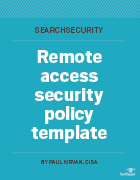
Alex - stock.adobe.com
How to create a remote access policy, with template
Remote work, while beneficial, presents numerous security risks. Help keep your organization's systems safe with a remote access policy.
Remote access enables employees and third parties to use an organization's systems and data from outside the network. Managing and securing this access is essential.
Organizations must establish policies and procedures that define acceptable secure remote access use as part of their overall cybersecurity management program. While most companies have cybersecurity policies in place, they might not specifically cover remote access or could require updating to include it.
In this article, learn how to prepare a formal remote access policy consistent with relevant technology standards and security best practices that also meets audit and compliance requirements. Use our free, downloadable remote access policy template to document your organization's policy.
Who does a remote access policy apply to?
A remote access policy covers any employee who remotely accesses an organization's data and systems. Third parties, such as partners, contractors, vendors and agents, that access corporate data and systems should also be included in a remote access policy.
Why do companies need a remote access policy?
Remote employees and third parties require access to IT and business resources, such as data, databases, applications, systems and networks, to maintain productivity and business operations. Access must be enabled whether they are, at home, in remote offices or on the go.
While remote working has multiple benefits, it introduces several security risks. A remote access policy helps ensure remote workers don't introduce business disruptions or cybersecurity incidents.
Who creates and manages a remote access policy?
Remote access policies are generally developed and managed by the security team in conjunction with IT and networking teams.
Creating a remote access policy involves a cross-functional team that also includes HR, legal and compliance teams. The team must address operational, legal, competitive and other considerations associated with remote access to data and IT systems. Teams should discuss internal departments' remote access requirements to accommodate various users' remote access needs.
What to include in a remote access policy
Remote access security includes the following activities:
- Implementing strong access controls.
- Measuring the effectiveness of security controls.
- Monitoring remote access activities.
- Managing secure remote access technologies.
- Keeping remote access rules and policies up to date.
- Testing remote access security operations.
Organizations need to prepare a remote access policy that addresses these activities and complement it with adequate technologies and employee training.
Some organizations address remote access in their existing cybersecurity policies. These must define remote access activities and how they build on existing policies and procedures, noting specific remote access metrics. Include additional detail, such as how to test the remote access part of the policy, if necessary.
Other larger or more complex organizations could require a separate and more specific remote access policy. These might include multisite companies that are geographically dispersed or organizations with many remote workers.
Remote access policies should account for the following:
- Criteria for granting employees remote access.
- Criteria for granting third parties remote access.
- Which resources remote users can access.
- Which access controls and technologies enable that access.
- Network resources needed for remote access.
- The security and IT employees responsible for executing remote access activities.
- Security requirements for physical devices and endpoints.
- Hardware and software configurations for remote access.
- Frequency of review of and change to remote access controls.
- Procedures to test and validate that remote access protocols and access controls perform properly.
- Periodic testing to ensure proper operation.
- Periodic auditing to ensure controls are being followed.
- Emergency procedures in case of remote access compromise.
- Integration of remote access into incident response, data breach response and other enterprise response plans.
Consider including the following technologies, processes and tools:
- Remote access protocols and technologies such as VPNs, RDP, Virtual Network Computing, SSH and zero trust, as well as remote access services.
- Access controls, such as MFA, the principle of least privilege, privileged access management, role-based access control, password security and zero-trust network access.
- Onboarding, offboarding and user access reviews.
- Data security controls, such as encryption, data loss prevention, SASE and backups.
- Network security controls such as firewalls, intrusion prevention and detection systems, and network detection and response.
- Wi-Fi security controls.
- Email security.
- Logging and monitoring.
- User and entity behavior analytics.
- Endpoint security and BYOD.
Include remote access in regular security awareness training. Educate users about remote access security risks and the importance of adhering to the remote access policy. Let users know the implications of noncompliance.
How to format a remote access policy
The following outline covers the main components of a policy:
- Introduction. States the fundamental reasons for having a remote access policy.
- Purpose and scope. Provides details on the policy's purpose and scope.
- Statement of compliance. Specifies laws, regulations, standards and other guidance the policy aims to achieve.
- Statement of policy. States the policy in clear, specific terms and includes the metrics stated in a previous paragraph.
- Policy leadership. Identifies who is responsible for approving and implementing the policy, as well as issuing penalties for noncompliance.
- Verification of policy compliance. Delineates metrics needed to verify that remote access security activities are verifiable and compliant with the policy and any other IT policies.
- Penalties for noncompliance. Defines penalties, including verbal reprimand or personnel file citation, for failure to comply with policy.
- Appendixes. Used as needed to incorporate additional reference data, such as lists of contacts and service-level agreements.
Consider linking to adjacent security policies, such as the information security policy, data security policy, password policy, network security policy, etc.
Software products are available to assist in preparing policies, including remote access, if necessary. Also consider the use of AI for remote access security. AI can help analyze remote access, for example, by spotting policy violations or the presence of malware. Some cybersecurity tools with AI features can automate detection and response activities or perform threat hunting to find suspicious activity, which can be especially important to protect remote access.
Paul Kirvan, FBCI, CISA, is an independent consultant and technical writer with more than 35 years of experience in business continuity, disaster recovery, resilience, cybersecurity, GRC, telecom and technical writing.








